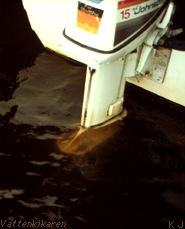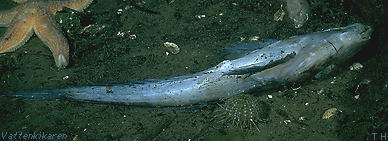
In the blooming pictured above, the density of dinoflagellates
have coloured the water dark red.
Problems from over-fertilizing can occur when production and consumption
are no longer in equalibrium; if there is a surplus of nutrients,
then production will increase to such an extent that existing organisms
are unable to consume this over-production. Plant plankton is responsible
for the majority of the Marine production. Normally two blooms
(sizable occurrences), occur yearly, during the spring and autumn.
|
During the spring bloom,
diatoms dominate, while during the autumn, dinoflagellates dominate
in the water. Alga blooms can occur when there are many nutrients
in the water, at the same time as there are a great many organisms
that eat plant plankton. This enables plant plankton to grow quickly
with the minimum of disturbance. This production occurs mainly in
the surface areas that are exposed to the sunlight. Animal plankton,
for example copepods,
are the largest consumers of plant plankton.
A well known example of an unusual alga bloom was
during the spring of 1988. The microscopic alga Chrysochromulina
polylepis bloomed along the Swedish west coast at a time of
relatvely low salt content, high water temperatures and abundant
supplies of nitrogen. The effects were catastrophic when many organisms
died or were weakened by the poison the alga produced. |



